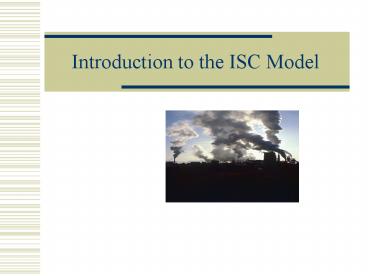Introduction to the ISC Model - PowerPoint PPT Presentation
1 / 15
Title:
Introduction to the ISC Model
Description:
It is a Gaussian plume model appropriate for a complex mixture of sources. ... The short term model also has more sophisticated capabilities for estimating the ... – PowerPoint PPT presentation
Number of Views:725
Avg rating:3.0/5.0
Title: Introduction to the ISC Model
1
Introduction to the ISC Model
2
Outline
- Model Overview
- Applications
- History
- How to Get the Model
- Input Data Requirements
- Model Tutorial
- Future Directions for Dispersion Models
3
Model Overview
- The Industrial Source Complex (ISC) model version
3 is a key regulatory model developed by EPA. - It is a Gaussian plume model appropriate for a
complex mixture of sources. - Chemical reactions can only be treated in a very
rudimentary way, thus the model is best applied
to non-reactive pollutants.
4
Model Overview
- There are short-term and long-term versions of
the ISC3 model. - They differ in the averaging times available for
data output. - The short term model also has more sophisticated
capabilities for estimating the effects of
terrain and deposition. - We will focus on the short-term model in this
workshop (ISCST3).
5
Applications
- The ISCST3 Model is widely used by the EPA, and
state and local environmental agencies to model
the effects of a variety of pollution sources. - The model can calculate average concentrations
over time periods ranging from an hour to a year. - Appropriate uses include
- Modeling to demonstrate sufficiency of proposed
State Implementation Plans (SIPs) for criteria
air pollutants. - Modeling to predict air quality impact of new
regulated sources. - Modeling to support assessment of health impacts
of air toxics.
6
History
- The ISC model has gone through several revisions,
each of which has added new capabilities (without
changing the Gaussian plume assumptions at the
heart of the model). - ISCST3 has new algorithms for wet and dry
deposition, a new way of simulating area sources
and a new method for simulating complex terrain.
7
How to Get the Model
- The primary source for the most up-to-date model
is the EPAs Support Center for Regulatory Air
Quality Models (SCRAM) website
www.epa.gov/ttn/scram - This site includes an already compiled executable
version of the model for running on a Microsoft
Windows computer operating system.
8
How to Get the Model
- It also contains all the original Fortran
computer code that can (with some difficulty) be
compiled to work on other computer operating
systems. - Note that the current version of the model
requires the use of the Lahey Fortran compiler.
9
How to Get the Model
- Note that the EPA version of the model is not
designed to be particularly user-friendly. There
is no graphical interface, so everything is done
with input and output files. - More user friendly interfaces for the models have
been designed by a number of private vendors. To
find one, just do an internet search for ISCST3.
10
Input Data Requirements
- Source Characteristics
- Source type, stack height, emission rate, stack
gas temperature, etc. - Meteorology
- Temperature, wind speed, wind direction, Pasquill
stability class.
11
Input Data Requirements
- Receptor grid
- Tells the model where in the model domain to
calculate concentrations. - Other model options
- Urban or rural
- Terrain
- Averaging time
12
ISCST3 Tutorial
- Section 2 of the ISC3 Users Guide, Volume 1
- www.epa.gov/scram001/userg/regmod/isc3v1.pdf
- Provides an introduction to the most frequently
used options in ISCST3 - Simulation is of emission of a non-reactive
pollutant from a single, isolated stack in a
rural area.
13
ISCST3 Tutorial
- Focuses on teaching the new user how to apply the
keyword/parameter approach to defining options in
the model - Input parameters are divided into six areas
- Overall job control options
- Information on the source(s)
- Receptor locations
- Meterology data
- Terrain grid
- Output options
14
ISCST3 Tutorial
- Goals for this exercise
- Get comfortable manipulating input/output files.
- Learn how to set up the input file correctly and
run ISCST3. - Become familiar with some of the key options
available in the model and how to change these. - Lets go the lab and do some modeling!
15
Future Directions for Dispersion Models
- ISC-AERMOD
- Based on a more sophisticated treatment of
boundary layer dynamics than is possible with a
Gaussian plume model. - Models-3 CMAQ
- Will provide more advanced chemistry for reactive
pollutants. - Plume within a grid to more realistically
simulate dispersion at multiple scales.































